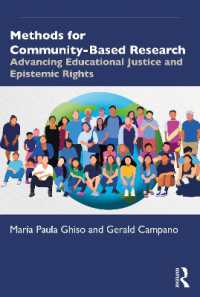- ホーム
- > 洋書
- > 英文書
- > Cinema / Film
Full Description
Indigenous Cultural Translation is about the process that made it possible to film the 2011 Taiwanese blockbuster Seediq Bale in Seediq, an endangered indigenous language. Seediq Bale celebrates the headhunters who rebelled against or collaborated with the Japanese colonizers at or around a hill station called Musha starting on October 27, 1930, while this book celebrates the grandchildren of headhunters, rebels, and collaborators who translated the Mandarin-language screenplay into Seediq in central Taiwan nearly eighty years later.
As a "thick description" of Seediq Bale, this book describes the translation process in detail, showing how the screenwriter included Mandarin translations of Seediq texts recorded during the Japanese era in his screenplay, and then how the Seediq translators backtranslated these texts into Seediq, changing them significantly. It argues that the translators made significant changes to these texts according to the consensus about traditional Seediq culture they have been building in modern Taiwan, and that this same consensus informs the interpretation of the Musha Incident and of Seediq culture that they articulated in their Mandarin-Seediq translation of the screenplay as a whole. The argument more generally is that in building cultural consensus, indigenous peoples like the Seediq are "translating" their traditions into alternative modernities in settler states around the world.
Contents
Introduction: Indigenous Modernity and the Translation of Seediq Bale 1. From Resistance to Compromise: Critical Women in the Mandarin Version 2. Refining the Ore: From Foreignization and Domestication to Fluency 3. The Game of Telephone: Cultural Translation as Adaptation 4. Pacifying the Pine: How to Demilitarize Headhunting Songs 5. The Dialectic of Dmahun: The Thicker Backtranslation of Cultural Keywords 6. From Hako Utux to Rainbow Bridge: Into the Translational Middle Ground 7. Translating Colonial Modernity: Adapting Terminologically Conclusion: The Thick Description of Indigenous Cultural Translation





